I occasionally like to flow between gaming experiences and think what they might be like as a whole. I have been playing more Elite Dangerous, this time on the early access version on Xbox One. Obviously I have talked about the game before and the kickstarter,and the oculus rift etc. Strangely though I am finding the “sofa version” even more engaging. There is a lot of sitting around in flying form place to place. It works really well on the joypad and the big TV too.
Yesterday one of the other game styles, the one on one fighting game finally got the character upgrade/DLC that I mistakingly thought was there are release. Mortal Kombat has been trickling out the DLC and now the Yautja/Predator set has arrived. Obviously I have quite an affinity with the character and the lore and I think they have done a really good job.
So I did this little xbox montage mashup showing one of characters in the story flying to a place to take part in a (gory comic book violence) fight. It was all recorded by just shouting at the kinect “xbox record that” then using upload studio in the xbox to stitch it together.
I used the training room for the predator vs predator fight, as it looks a bit like a docking bay. Its more of a short poem than a feature film, ideal for our internet attention spans. It shows of some of the nice predator work, both with and without facemask. Some plasma cannon action in there too.
Of course like all great expansive games like elite it would be great to be able to get out of the ship and do stuff like this. I guess that may come though No Man’s Sky may beat them to that 🙂
games
Alone in a crowd – RPGs and MMORPGs
Free roaming role playing games are one of the most intriguing style of games and experiences to engage with IMHO. I use the word experience, not just games, in order to encapsulate the social environments and metaverse’s such as Second Life, Hi Fidelity et al. However I also did not just restrict that first sentence to include online massively multiplayer/multiuser online. There have been two significant release the past few weeks that are both huge expansive free roaming role playing games The Witcher III and Elder Scrolls online – Tamriel Unlimited. . I have been struck by a few experiences that I have had in these environments. Ones that reach past just playing a game or getting some points/gold/kudos/screenshots.
If you are not a gamer, or don’t engage with these sorts of things they may seem almost identical. They are certainly in a genre and have lots in common.

Witcher III – Xbox one
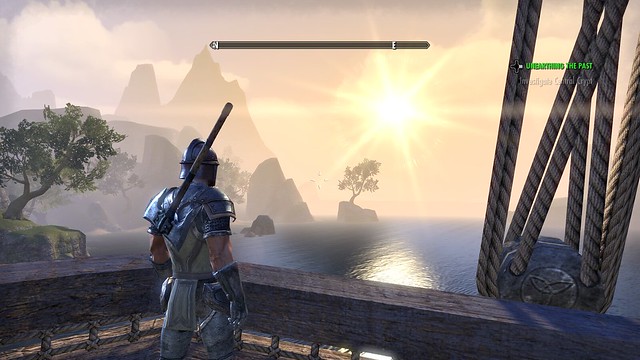
Elder Scrolls – Xbox One
As you can see in both you are able to take a break from any action and just appreciate the environment. This is not intended to be a graphic comparison though the slightly different styles, yet still aiming for the “real” is noticeable in these two examples.
Witcher III is a single player game. It is a story driven plot. A very long story it would seem too. Like all role playing games it rewards your play with new skills, levels and abilities as you level up. You gradually unlock the very expansive world with all its challenges and new types of monsters and bad guys as you progress through the main storyline. This generally involves traversing the world searching and fighting in various ways. It has a 3rd person style of free form combat. You choose the type of weapon and various potions and armour to give you a fighting chance against increasingly higher level creatures. You can just wander off the plot and the beaten track and see what you bump into. However this particular RPG reminds you constantly that whilst you might feel you have learned a lot there is still more levelling up to do as you arrive at a place in a world full of things that can cut you down with a single strike. Level systems in RPG’s generally appear as numbers on the display. When you have spent 20 hours playing and just reached level 7 and you wander into a clearing with a large beast that says level 35, where level progression is non linear and requires exponentially more effort and time per level you know you are in trouble. Witcher reminds you that no matter how heroic and skilled you thing you are, there is always something bigger and better. It has a grittiness to the entire game that brings a sense of foreboding, yet it is still entertaining. However you are very much alone and left to your own devices.
Elder Scrolls Online – Tamriel Unlimited is a very different feel and a very different experience. It is Skyrim (the one player RPG from a few years ago), reborn into a persistent Massive Multiple Player Online experience. Skyrim had been noted for it’s random generation of dungeons combined with its epic land size and the variation of things that you ended up doing in the virtual environment. Elder Scrolls has both a 3rd person and a 1st person view. The latter lets you see the world, and just your hands/ weapons. It lets you use each and on its own, weapon and shield combinations. The weapon can be ranged magic in one hand and a sword in the other. You travel the world finding missions from non player characters. Most of these involve collecting, running to and fro and just like the Witcher III putting things together and crafting items you need, potions, armour, magic, food etc.
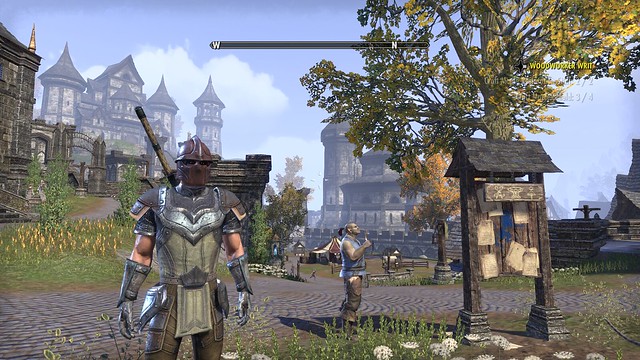
So unlike Witcher III your character is in the environment with lots of other people. Just like the other giants of the MMORPG genre, World Of Warcraft and Eve Online. It is quite unusual for this sort of genre to make it to a console. Usually these platforms get multiplayer shooters where 16-32 people battle for a few minutes in an arena that is then destroyed and reformed for the next battle.
Here we have a world that we all share, all the time. Of course the technical detail of which server, or how anyone is actually in the “same” place is obscured and not entirely relevant to the experience. Also the world itself is generally a locally loaded place. The servers are there to broker player position, communication and hold certain shared features in the experience, but it is not really a full persistent world.
I have found it works really well as a game to be wandering around, getting engrossed in each task, gradually levelling up, choosing skill tree paths, working out what to carry, sell, deconstruct and to craft. Lots of the missions from the non player characters are actually there to help you learn the very complex system of crafting as much as forwarding any plot line points. Choosing missions chooses various guilds and organisations to which you belong.
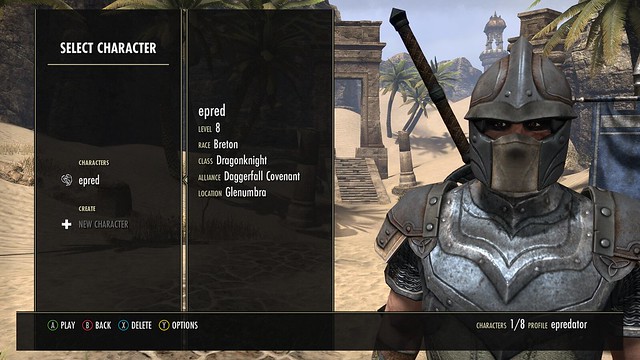
I called this post “alone in the crowd” because it is a particular feature of this style of environment that you do see lots and lots of other people, milling around playing their own missions, but you do not have to interact with them if you don’t want to. Though sometimes it is unavoidable, or required to work in a team.

This is by no means a crowd shot! but the character not the right is just running off somewhere. They ran past me, I paid no attention to them, nor them to me other than we just both know we are part of the human noise of this virtual city.
Most things are not restricted based on numbers in the free roam areas. For example the blacksmith station is a object you have to walk up to, select and then take part in an inventory management/crafting dialogue. The things you are doing are entirely related to you and your experience, but we all have to gather around the anvil in order to do this. This is good when there are only a few people, but when it’s busy the room is full of lots of gormless characters standing around.
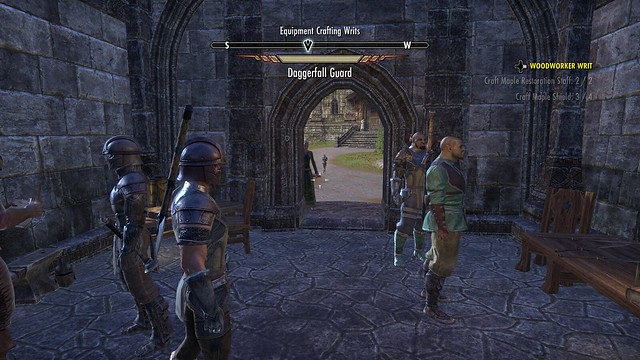
Passing one another in the world feels like something we normally do, it adds to the sense of a shared experience, but all standing around staring into space, or watching people traverse the land mostly by jumping and bounding around in order to get for a to b quickly starts to look like a complete mess of uncoordinated activity. Which of course, it is 🙂
This is a feature of most virtual world online experiences. The only time it is not is when people are more seriously role playing and rules are set to preserve the experience. This happens in some areas in Second Life where you are encouraged to be wearing the right clothes, speaking the right way to join in with the entertainment of acting. Rather like not turning at a real life roman re-enactment on a segway wearing a stetson.
That is not to detract from the game, or games like it. This is a genre where stuff like this has to happen due to the way the tech works, but also the way people work. It is funny, but it can be a jolt in the immersion.
Where this sharing of space does work though is in battles with things in the environment and things in it. You can be wandering around exploring and then be set upon by a pack of wolves. When you start fighting it becomes “your” battle. However other people passing by can also see and join in with that battle, or choose it ignore it. Those wolves become a shared experience. There are a lot more bad guys than wolves but it’s an easy example to use. For a short period of time, you and the others who just happen to be there at the time are no longer alone. You are working with the same problem. Now this could just be thought of as a few experience points of resources to add, share split, ignore but it has all sorts of extra dynamics.
If you see someone in trouble, do you help ? Does your helping actually hinder and annoy them? as they were challenging themselves and their character.
Sometimes you just have to join in in order to be able to get the things you need to proceed. In one particular example the bits of a monster were needed in order to escape an area. If someone else kills the monster before you get any sort of hit in then you are not credited with any part of the kill so do get the bits you need. This meant waiting, or searching for another one of the same type, waiting for a re-spawn and getting in there before the rest of the crowd. Game design and rules may have altered how many people might be competing for this single resource, and I did escape, but it was an interesting co-opetition dynamic.
This led also to another thought on timelines, on the immersive experience and how we are often reminded of our place in these virtual worlds. Having worked towards a small piece of the plot and defeated a particular boss, whereby a slight levelling occurred, new kit and a small buzz of excitement at having completed something, whilst standing near the same spot taking stock a new crowd arrived. Of in the distance I heard the bad guy arrive again, go through the same “No mr bond I expect you to die” style of dialogue. I watched from the distance as my fellow travellers and gamers fought the same battle, but in a different way. In my timeline, this battle was over. I was stood in what was attempting to be a coherent virtual experience being reminded I was not. It is not a problem, as such, but it is a thing.
It is reminder and a breaking of the story. Yet I think there may be something in this kind of feeling of immersion and then shocking back into reminders it is not real. It is an accident of the technology restrictions that cause this to happen. It is a technique used in other media when the action breaks the plane to the fourth wall. When a stage actor talks to the audience when previously the audience were passive. Some of the most chilling of these have been Kevin Spacey in House of Cards. The very occasional, to the point you think they have forgotten to write any in, turning to the audience and engaging in dialogue is very special. One of the most memorable being “Oh did you think I had forgotten about you?” still gives me goosebumps thinking about it.
It should not matter if we choose to form clans and take on multiplayer missions, or just act on our own in these worlds. The very mechanism we are using has the ability to reach back out to us and surprise us. I have felt this in games just a few times. It may be a party trick in some cases but reaching out to the human, through the role play, through the immersion may just be the most memorable and entertaining thing a virtual world can do.
Project Cars – High speed virtual world
Project Cars went live across consoles and PC last week. I am a big fan of racing games. Of all the genres they are my favourite. Forza on the Xbox has been my go to game for driving fun so I decided on the PS4 version of Project Cars in the hope I would have a good racing game on either console. I was not let down at all!
Project Cars looks, sounds and more importantly feels like a proper racing game. Where it differs to some of the other recent games is the inclusion of some very low end racing with Karts and Super Karts. The mid range road cars and GT cars in general feel good and solid, the Karts are twitchy and manic and amazing fun too.
There is a lot of customisation of how you play that can be done in Project Cars. I just put it on the medium setting for everything and got re-aquainted with the PS4 controller. What you need to do in Project Cars is be very very subtle with power and the steering with some of the car models. Tank slappers and oversteer can be very unforgiving in some of the classes. Project Cars, like all good racing games rewards practice. The feeling of getting to grips, just, with a class of car and putting in some fast laps, knowing you can shave even more time off is at its core.
So we have a very good physics model and huge array of classic racetracks. So that’s all good so far. A good physics model and a feel for driving has been in every game I have enjoyed from back in the Night Driver day to pole position, the mighty Sega Rally, Colin Mcrae Rally, Gran Turismo and finally Forza. What they all have gradually added and improved on top of the physics and feel is the look.
I always prefer an in car view. (These will be even better with the VR headsets). Project Cars adds a really interesting view from inside your crash helmet (it has lots of views to choose, including a centre of the cockpit view even for cars that are not central drive). The crash helmet view also muffles the sound just a little. It does some interesting fx with focus blur and forcing your head to bobble back and forth with acceleration. As you can see in this photo elements of the view are blurred on purpose. It is a sort of tilt shift effect that is very pleasing live.
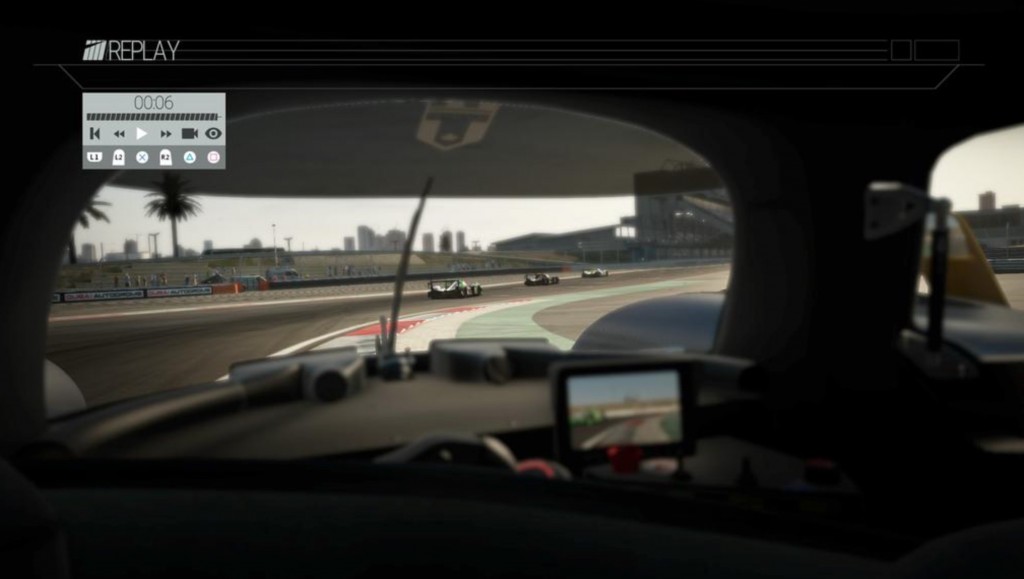
There are also some very effective weather dynamics, rain is quite terrifying as you hurtle along having turned on your windscreen wipers. (Oddly my first wet race nothing told me I had wipers but I mashed a few buttons and found the down dpad turned them on). The haze and the rain drops, including the sounds of them is very clever.
Other games have realtime weather and lighting but Project Cars just has more and better.
The solo career lets you pick a class to start in, like Karts, and work your way up. It is not long before you get to invitational races in all sorts of classes so it does not force too much monotony like a real career might 🙂
You can always hit single race and pick any car, any track any time with 30+ other cars on the track with you too.
An unusual feature on the PS4 is the pit radio messages, as they come out of the controller speaker, which is a nice touch.
On the 360 I had a very good force feedback wheel and pedals for Forza, but it doesn’t work on Xbox One. It made a great deal of difference to times, and to be abel to make sensible gear changes. Pads just don’t suit gears IMHO. Project Cars works with the pad but I am sure would be greatly enhanced with a wheel and pedals.
I tend to leave the driving line on when i don’t have a real wheel and force feedback as it fills in for the lack of sense of speed you can suffer from in any game with only rumblers. I would prefer to be driving without out but I think at the moment I will stick with it 🙂
The tracks are very notable too in Project Cars, all there straight away, as are the cars. No pretend economy to have to buy your way up. Donnington, Oulton Park, Snetterton, Brands Hatch, Imola, Monza, Nordshleife are all there.
Like all good car games there are a stack of tuning options, damage models, tyre wear, pit strategies and aero set ups. Pit stops, if the race is long enough or the rules dictate, let you pick a strategy from a set you have made for that stop.
Probably the maddest option though is the real time actual 24 hour race. There is an achievement for that ! It suggests you get some mates over and take turns driving. So when you enter pits there is an option to swap driver. As only I was signed in I tried the sea driver and an AI driver took part for me. I am not sure it it counts leaving him to do 24 hours, but I am sure the inter web will provide the answer to that.
The launch trailer is below. It does look like this and does not disappoint. I am sure the high end PC version is even more glorious and may make this the standard to beat.
Just Cause 3 – Its been 5 years since ….
It’s been five years since I wrote this post about Just Cause2 in which I mentioned “Sandbox games are the closest to what we see in virtual worlds in crossover terms. Just Cause 2 is a single player game, in part because the destruction you create is really personalising your island. However the balance between “give me something to do” and “I am just going to find something to do” may be something the VW providers and content creators need to consider in helping people find a narrative, either social or business related.”
Well I stand by that. The mix of ready made tasks, ongoing narrative plot live and freedom to find your own things to do as you wander around is a core theme in some of the most enjoyable experiences. Minecraft, Goat Simulator, GTA V Watch Dogs etc.
Now we have the reveal of gameplay for Just Cause 3. Which if nothing else looks fantastically exciting 🙂
Fingers crossed it is as good as the last one, it certainly looks it.
Amiga kickstarter book, breaking mirror worlds & VR
A few days ago my copy of the book “Commodore Amiga: a visual Commpendium book” that I backed in Kickstarter arrived. The book is by Sam Dyer through BitmapBooks. It came with a load of extra goodies from my backing and my name along with my fellow backers vanity printed in the appendix. The only slight problem was that unlike all the other Kickstarter campaigns I wasn’t “allowed” to have a credit as epredator as it made the list look untidy unless we had normal names. That is the authors choice of course 🙂
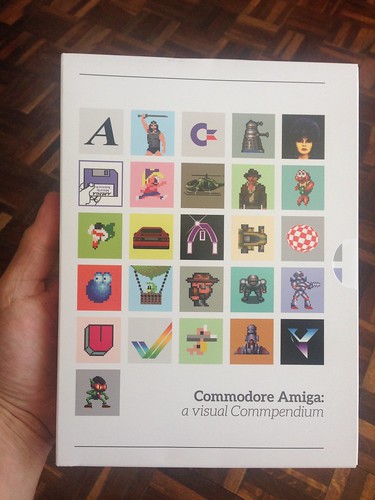
My computer owning history went ZX81, Commodore 64 then Amiga 500 (and later 1200). The Amiga was 1987 and became my main machine for most of my polytechnic/university time. It caused me to get an overdraft for the first time to buy an external hard drive for a piece of work I was doing (that and to play the later cinemaware games that needed two floppy disk drives to work).
It was the machine I coded my final year project, which was a mix of hardware and software but also had to work on the much larger and more expensive Apollo computers we had.
It is the machine I spent ours with sellotaped together graph paper planning my SimCity builds and mapping Bards Tale Dungeons.
It is also the machine I first experience proper network gaming on with a null modem cable and F/A-18 flight simulator. Not only was that the first proper LAN party gaming but it forged the idea that machines do not have to have a consistent shared view of the world just because they are connected. The F/A-18 simulator let my good friend Wal and I fly around shooting at one another in a shared digital space. It was the early days of having a printer and being able to do “desktop publishing” aka DTP. I even produced a poster for our little event.
When we played we had different terrain packs running on each Amiga as we had different versions of the game. There was no server this was really peer to peer. The terrain was local to each Amiga, but the relative location of one another in that space was shared. Each machine was doing its own collision detection. It meant if I saw mountains I needed to avoid them, yet on the other machine that same local space might be flat desert. We all perceive reality differently anyway, but here we were forced to perceive and act according to whatever the digital model threw at us. In reality we kept to the sky and forcing your opponent into their own scenery was considered unsporting (though occasionally funny and much needed).
This set the precedent for me that whilst mirror worlds, virtual worlds that attempt to be 100% like a real place, have a reason to exist we do not have to play by the same physical rules of time and space in virtual environments.
Other things of note about the Amiga. Well I coded as predator on the Commodore 64 and that moved across to the Amiga too. The e was a later addition on the front by the principles are the same.
My wife also discovered gaming on my Amiga. Getting completely wrapped up and in the zone on Sim City and realising it was 4am. Later it would be Lemmings that caught her attention. Hence she is now elemming on twitter.
The book is full of classic images nearly all of which I have some sort of memory of that is more than yes I recognise that picture.
Games like Alien Breed (a gauntlet like top down shooter) and The Secret Of Monkey Island (a classic point and click humorous adventure) on their own rack up considerable hours of entertainment for very different reasons
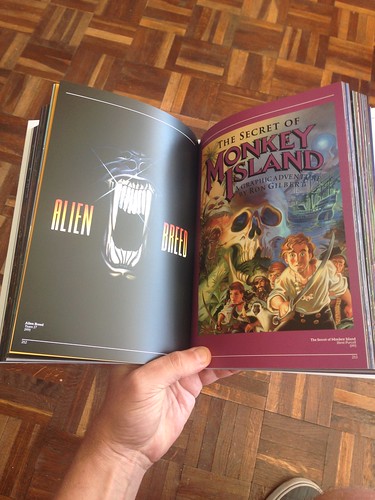
Whilst fondly reminiscing and remembering things that impact how I think and work today I was also at the same time in current and future mode. Right next door on the table was my copy of Games(TM)

As I tweeted at the time My life history in 1 picture #nearly #amiga #vr #metaverse.
When we put on a headset, a total immersion one, we get a view of a world that is instantly believable. Something fed directly to our eyes and linked to the direct we are looking becomes a convincing reality. In a shared virtual world we will assume that we are all seeing the same thing. That does not have to be the case, as with the F/A-18 example. We can have different experiences yet share the same world. To help think about that consider the game Battleships. Each player has the same map, the same relative grid references on a piece of paper or on plastic peg board. yet on that map you can only see your own boats and any pieces of information you have gained through playing. When considering a mirror world or a virtual world build it can be harder to consider this. Yet many games and environments already have a little dollop of this behaviour with personal displays of health, ammo, speed etc in a Heads up Display. Those HUDs are an augmented reality display in a virtual world.
When we now consider the blended view headsets like the HoloLens and the MergeVR we are taking the real world as the server in effect. It is a fixed environment. We are then placing and enhancing what we see in that world with 3D overlays. Convincing the viewer the digital stuff is real.
Unlike the F/A-18 terrain the real world is there for each person. If there is a table in the middle of the room, even if you make it look like it is not for a headset wearer with object removal and clever visuals they will still trip over it. However the other way around can make for an interesting dynamic. headset wearers made to think there are obstacles and things in their way that they have to move around, but its different for each headset wearer. Just a little though experiment in perception. I didn’t even throw in anything about 3D printers actually making the new obstacles in the real world. That’s a bit much for a monday morning.
Anyway, the Amiga book is great. It was a fantastic period in games and in home technology, but we have many more exciting times coming.
What’s the point of Goat Simulator?
Firstly, this is not me asking the question. It was something that just happened and serendipity took over to explain. For this of you who have not experienced goat simulator on any platform it is… well… a… Goat Simulator. In fact it is a large physics sandbox were you happen to gallop around as a rather difficult to control goat, jumping, bashing, licking and rolling around.
It makes no bones about its perfection, or lack of it. The physics is good but the collision detection is wonky at times, but thats its charm. It has many elements you would find in skating game. Points systems, achievements and just a little tricky on the controls.
I bough GS a while back on the Mac when we were on holiday and we had a joke about the menacing look from the goats. Now it is there on Xbox One for only £7.99 so well worth it as its hilarious.
Now many hardcore gamers may be busy on the PS4 trying to deal with Bloodborne. Which is, IMHO, just too damn hard despite being fantastic.
GS is just fun, its a sandbox game, you make of it what you want, find your own paths and challenges.
Now @elemming was sitting playing some resource farming game on the ipad and happened to say “what’s the point of goat simulator?”. Just at that point this happened. I butted a pedastrian who ran off and… well watch the video. It made elemming bust into laughter about 30 seconds after looking up and saying “Whats the point….”
Well thats the point 🙂 it’s just fun, with some challenges.
Games can be that, or games can be very serious and intensely stressful. They all work, they are all worth exploring and they all fit various situations. The fact this is a virtual world of course fits with what I do for a living. However it’s all good
Over 15 years experience in Virtual Worlds, 30+ in tech – What now?
A few days ago I realised it has been over 9 years since I first publicly blogged about how important I thought the principles of the metaverse and virtual worlds were going to be for both social and business uses. This post, pictured below for completeness was a tipping point for some radical changes in many of our lives as part of Eightbar.

I had been working to that sort of point of understanding though since some very early work with virtual environments and how people get to interact with one another in them around 1999/2000 with SmartVR trying to keep the social bond in our internal web and multi media design group together when we were cast asunder to different locations by business pressures (or bad decisions who knows!). I knew we had to have a sense of one another existence aside from text in emails and instant messages. So we tried to build a merged version of both offices as if they were in one place. The aim to then instrument those with presence and the ability to walk over to someone’s desk and talk. Mirror world, blended reality and even internet of things, Yes I know, a bit before its time! Cue music, “Story of my life” by 1D 🙂
We definitely had a technology and expectation bubble later 2006-2009. However, that, as with all emerging technology is all part of the evolution. The garnet curve et al. What surprises me the most still is that people think when a bubble like that bursts that its all over. That somehow everything that was learned in that time was pointless. “Are virtual worlds still a thing?” etc. I feel for the even earlier pioneers like Bruce Damer, who patiently put up with our ramblings as we all rushed to discover and feel for ourselves those things he already knew.
Increasingly I am talking to new startup ands seeing new activity in the virtual space. The same use cases, the same sparks of creativity that we had in the previous wave(s), the same infectious passion to do something interesting and worthwhile. Sometimes this is somehow differentiated from the last wave of virtual worlds under the heading of virtual reality. The current wave is focussed on the devices, the removal of keyboard and of a fixed screen. The Oculus Rift, HoloLens etc. However, thats a layer of new things to learn and experience on what we have already been through. After all its a virtual world you end up looking at or blending with in a VR headset!
I spend so much time looking forward and extrapolating concepts and ideas it is now very scary to look back and consider the experience I have gathered. The war stories and success stories, the concepts and ideas that I have tried. The emotional impact of virtual worlds. The evolution of the technology and of people’s expectation of that technology. The sheer number of people that have moved around in a 3d environment from an early age with things like Minecraft, who are now about to enter higher education and the workforce.
So I am left in a slightly bemused state as to what to do with this knowledge. With this all going so much more mainstream again I am no longer working in a niche. Do I ply my trade of independent consulting chipping away in odd places and helping and mentoring some of the new entrants in the market or do I try and find a bigger place to spread the word?
At the same time though, knowing lots of things makes you realise how much you don’t know. The imposter’s syndrome kicks in. Surely everyone must know all this stuff by now? It’s obvious and stands up to logical reasoning to try and connect with other people in as rich a way as possible. The network is there, the tech is there, the lineage is there. Though clearly not everyone gets it yet. I often wonder if the biggest naysayers I had to deal with on my journey so far have figured it out yet? It will probably turn out they will be getting rich quick right now whilst I sit and ponder such things.
On the other side of the virtual coin, I know from my martial arts that constant practice and investigation leads to a black belt. In the case of Choi Kwang Do that’s just over 3 years worth. So how many Dan worth of tech equivalent experience does that put me at. 25 years in the industry professionally but 30+ as techie.
I still want to do the right thing, to help others level themselves up. I don’t think I am craving fame and fortune but the ability to share and build is what drives me. If fame and fortune as a spokesperson, evangelist for some amazing idea or TV show reaches that end, then thats fine by me.
I am at a crossroads, my VR headset letting me look in all directions. I see half built roads in many directions. What now? A well funded company that I can help build a great road with, or forge off down one for the other paths seeing what happens on the way.
Of course that makes it seem like there is a clear choice on the plate. I suspect most of the the well funded companies and corporations don’t think they need any help, which is rather where I came in on this!
Needless to say I am always open to conversations, offers, partnerships, patronage, retainers and technology evangelist roles. There must be a slew of investors out there wondering what to put their money into, who need some sagely advice ;). Or that book… there is always that book… (600 images x 1000 words each 600,000 words just on these Second Life experiences. That’s just the ones with online. The offline ones double that!. Not to mention the other places, games, and self built experiences!
I took this photo in April 2006 as part of sharing of our journey

I have always liked a nice greenfield to start building on. Equally that did not build itself, it was a massive shared team experience. No one has all the answers. Some of us are good at helping people find them though.
Right! Can we get on with this now?
Kids,video games, parents and ratings
There has been a lot of press and discussion about schools in the UK writing to parents to warn them about young children playing video games. Also indicating that allowing kids to play games rated 18 when they are underage is a sign of neglect and will lead to the parents being reported to police. The BBC covered it here
As a parent, as a school governor, an instructor and long term gamer it seems that this raises a few much more complex issues.
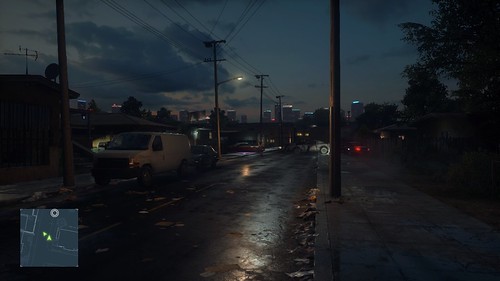
An 18 certificate on anything helps flag up content of a nature regarded as adult. However it does not indicate which of the adult themes it contains. You may notice on films on TV it will say its 18 but whether it contains violence, drug use, nudity, etc. That informs the viewer if they are sensitive or prefer not to watch such things to avoid it.
A parent should know what is in a product that they let their kids loose on. The 18 should be a big flag warning that there may be something in there that is not appropriate. However not all parts of all games are really 18 worthy. It is a marketing ploy to get more adult gamers to slip a few things in sometimes to warrant an 18. It also is down to individual parents bothering about how notice if their kids are affected or going to be affected by certain things.
Make no mistake though, there are some things in games that are really properly challenging and grown up experiences. Sometimes they can sneak up on you and often come as part of a wider narrative. As an example in Red Dead Redemption, an 18, the vast majority of the game is spent riding around the Wild West on a horse. Yes there are gun fights and shooting. However it is no more or less than watching a John Wayne movie.
“John Wayne – 1961” by 20th Century Fox – eBay. Licensed under Public Domain via Wikimedia Commons.
Cowboy movies sometimes have to deal with complex issues but they come in many flavours. There is always lots of shooting and death but it is the core and the intent of the film, either being light and comical or the more gritty true to life versions that form the spectrum. RDR seemed in the most part to be the former. I grew up watching westerns and we all had six shooters for toys.However about 2/3 through as the character arrives in Mexico a story telling cut scene featured graphic rape scene. Usually you get a sense and feel for the spirit of a game as you play it. You spot that it might be a cert 18 because of the “violence”, this though seemed a shift.
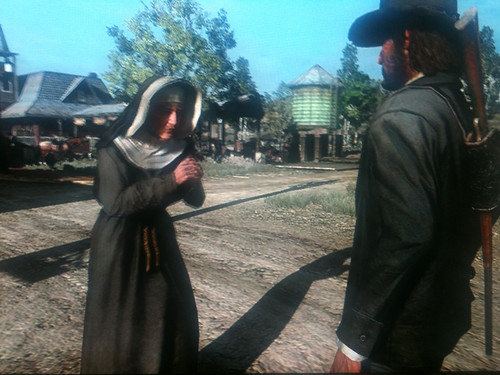
Now lets take Call of Duty (Bear in mind you can get Call of Duty Lego). The single player campaign game in all these games is a full on war film equivalent. However it is more Saving Private Ryan than Where Eagles Dare.
Both great films, but the former is realistic and disturbing, the latter is a playful romp. So single player you will experience some degree of story, probably torture, murder et al. Also some very strong language. It changes a great deal in multiplayer. Here teams of people online shoot at one another and work as teams to capture objectives. The violence is more Where Eagles Dare. It is frenetic and fast paced. The risk here comes from the other people, with headsets and voice turned on then all sorts of bullying and offensive language can take place, equally friendly banter and trash talk. Or, when done right excellent teamwork. The soundtrack itself features very little produced content. The narrative is what you make it.
In many ways the multiplayer COD is less worrying than what can happen on a Minecraft server. Minecraft as a game feature the ability for people to treat one another nicely or nastily. Whilst there is not usually voice you can spend ages building something for someone to come and mess it up accidentally or maliciously. It can also be a great place to learn online etiquette. Minecraft is not an 18. You kill things, but its regarded as cartoon and left alone. It has no story to warrant someone put in some nasty scenes to provide an emotion.
My point is that 18 is a flag, a warning sign. It takes a bit of effort to drill down if you are going to let kids experience the good parts of these.
I am happy for kids to shoot at one another in these games, it is just a twitch reaction game. I am not happy for them to play the single player experiences, those things crafted to shock and engage adults on adult themes. So I wonder if that makes me negligent? Being happy that kids can see some content that is put under an 18 certificate?
This of course is not what is going to happen. These warnings are to remind parents to be parents, to think about what they are doing, to help guide their kids.
Both the predlets are martial artists. They train in punching and kicking in ways that if used properly are very dangerous. They see punches and kicks all the time yet it is all done in a positive way, one that is not about the aggression of the will to dominate others. They are taught to not misuse what they learn in class. Does that mean that playing a fighting game with an rating over their age is not appropriate, often these at 16 like the UFC game or even WWE?
So all this comes down to context. To understanding when game does not mean light hearted play but intense narrative. It means understanding when competition is or isn’t healthy. It requires us as parents to understand a what is going on in these experiences and how we can find the appropriate path for our kids.
The age rating on these things is a relic of a past approach to media. It is very easy to classify 2 hours of celluloid, The 18 certificate is then a barrier to entry to a cinema when a person is selling a ticket, or even buying a DVD.
Games and their associated places are far more complex. They are playing fields where at different times with different groups very different things happen.
I am not totally sure how we can help all the parents out there. Many of course will just not bother to apply any thought at all and just let their kids on anything, on the basis it is easier.
A great week for science and tech, games, 3d printing and AR
There is always something going on in science and emerging technology. However some weeks just bring a bumper bundle of interesting things all at once. Here in the UK the biggest event had to been the near total eclipse of the Sun. We had some great coverage on the the TV with Stargazing live sending a plane up over the Faroe islands to capture the total eclipse. I was all armed and ready with a homemade pinhole camera.

This turned out great but unfortunately we were quite overcast here so it was of little use as a camera. I also spent the eclipse at Predlet 2.0 celebration assembly. They had the eclipse on the big screen for all the primary school kids to see. Whilst we had the lights off in the hall it did not get totally dark, but it did get a bit chilly. It was great that the school keyed into this major event that demonstrates the motion of the planets. So rather like the last one in 1999 I can certainly say I will remember where I was and what we were doing.(a conversation I had with @asanyfuleno on Twitter and Facebook)
This brings me on to our technological change and the trajectory we are on. In 1999 I was in IBM Hursley with my fellow Interactive Media Centre crew. A mix of designers, producers and techies and no suits. It was still the early days of the web and we were building all sorts of things for all sorts of clients. In particular during that eclipse it was some more work for Vauxhall cars. We downed tools briefly to look out across Hursley park to see the dusk settle in and flocks of birds head to roost thinking it was night.
It does not seem that long ago but… it is 16 years. When we were building those quite advanced websites Amazon was just starting, Flickr was 6 years away, Twitter about 7 years away, Facebook a mere 5 (but with a long lead time) and we were only on Grand Theft Auto II, still a top down pac man clone. We were connected to lots of our colleague son instant messaging but general communications were phone and SMS and of course email. So we were not tweeting and sharing pictures, or now as people do live feeds on Meerkat. Many people were not internet banking, trust in communications and computers was not high. We were pre dot.com boom/bust too. Not to mention no one really had much internet access out and about or at home. Certainly no wi-fi routers! We were all enthralled by the still excellent Matrix movie. The phone in that, the slide down communicator style Nokia being one of the iconic images of the decade.
NB. As I posted this I saw this wonderful lego remake of the lobby scene so just had to add it in this post 🙂
It was a wild time of innovation and one many of us remember fondly I think. People tended to leave us alone as we brought in money doing things no managers or career vultures knew to jump on. So that eclipse reminds me of a time I set on a path of trying to be in that zone all the time. I was back then getting my first samples from a company that made 3d printers as I was amazed at the principle, and I was pondering what we could do with designers that knew 3d and this emerging tech. We were also busy playing Quake and Unreal in shared virtual worlds across the LAN in our downtime so I was already forming my thoughts on our connection to one another through these environments. Having experiences that I still share today in a newer hi tech world where patterns are repeating themselves, but better and faster.
That leads me to another movie reference and in the spirit of staying in this zone. This footage of a new type of Terminator T-1000 style 3d manufacturing. 3D printers may not be mainstream as such but many more people get the concept of additive manufacture. Laying down layer after layer of material such as plastic. It is the same as we made coil clay pots out of snakes of rolled clay when we were at school. A newer form of 3D printing went a little viral on the inter webs this week from carbon3d.com. This exciting development pulls an object out of a resin. It is really the same layering principle but done in a much more sophisticated way. CLIP (Continuous Liquid Interface Production) balances exposing the resin to molecules to oxygen or to UV light. Oxygen keeps it as a liquid (hence left behind) and targeted UV light causes the resin to become solid, polymerization. Similar liquid based processes use lasers to fire into a resin. This one though slowly draws the object out of the resin. Giving it a slightly more ethereal or scifi look to it. It is also very quick in comparison to other methods. Whilst this video is going faster than actual speed it is still a matter of minutes rather than hours to create objects.
Another video doing the round that shows some interesting future developments is one from Google funded Magic Leap. This is a blended reality/augmented reality company. We already have Microsoft moving into the space with Hololens. Much of Magic Leap’s announcements have not been as clearly defined as one might hope. There is some magic coming and it is a leap. Microsoft of course had a great pre-release of Hololens, some impressive video but some equally impressive testimonials and articles from journalist and bloggers who got to experience the alpha kit. The video appeared to be a mock up but fairly believable.
Magic Leap were set to do a TED talk but apparently pulled out at the last minute and this video appeared instead.
It got a lot of people excited, which is the point, but it seems even more of a mock up video than any of the others. It is very ell done as the Lord of the Rings FX company Weta Workshop have a joint credit. The technology is clearly coming. I don’t think we are there yet in understanding and getting the sort of precise registration and overlays. We will, and one day it may look like this video. Of course it’s not just the tech but the design that has to keep up. If you are designing a game that has aliens coming out of the ceiling it will have a lot less impact if you try and play outside or in an atrium with a massive vaulted ceiling. The game has to understand not just where you are and what the physical space is like but how to use that space. Think about an blended reality board game, or an actual board game for that matter. The physical objects to play Risk, Monopoly etc require a large flat surface. Usually a table. You clear the table of obstructions and set up and play. Now a project board game could be done on any surface, Monopoly on the wall. It could even remove or project over things hung on the wall, obscure lights etc. It is relying on a degree of focus in one place. A fast moving shooting game where you walk around or look around will be reading the environment but the game design has to adjust what it throws at you to make it continue to make sense. We already have AR games looking for ghosts and creatures that just float around. They are interesting but not engaging enough. Full VR doesn’t have this problem as it replaces the entire world with a new view. Even in that there are lots of unanswered questions of design, how stories are told, cut scenes, attracting attention, user interfaces, reducing motion sickness etc. Blending with a physical world, where that world could be anywhere or anything is going to take a lot more early adopter suffering and a number of false starts and dead ends. It can of course combine with rapid 3d printing, creating new things in the real world that fit with the game or AR/BR experience. Yes thats more complexity, more things to try and figure out. It is why it is such a rich and vibrant subject.
Just bringing it back a little bit to another development this week. The latest in the Battlefield gaming franchise Battlefield Hardline went live. This, in case you don’t do games, is a 3d first person shooter. Previous games have been military, this one is cops and robbers in a modern Miami Vice tv style. One of the features of Battlefield is the massive online combat. It features large spaces and it makes you feel like a small spec in the map. Other shooters are more close in like Call of Duty. The large expanse means Battlefield can focus on things like vehicles. Flying helicopters and driving cars. Not just you though, you can be a pilot and deliver your colleagues to the drop zone whilst you gunner gives cover.
This new game has a great online multiplayer mode called hotwire that apps into vehicles really well. Usually game modes are capture the flag or holding a specify fixed point to win the game. In hotwire you grab a car/lorry etc and try and keep that safe. It means that you have to do some mad game driving weaving and dodging. It also means that you compatriots get to hand out of the windows of the car trying to shoot back at the bad guys. It is very funny and entertaining.
What also struck me was the 1 player game called “episodes”. This deliberately sticks with a TV cop show format as you play through the levels. After a level has finished the how you did page looks like Netflix with a next episode starts in 20 seconds down in the bottom right. If you quite a level before heading to the main menu it does a “next time in Battlefield Hardline” mini montage of the next episode. As the first cut scenes player I got a Miami Vice vibe which the main character then hit back by referencing it. It was great timing, and in joke, but one for us of a certain age where Miami Vice was the show to watch. Fantastic stuff.
I really like its style. It also has a logo builder on the website so in keeping with what I always do I built a version of the Feeding Edge logo in a Hardline style.
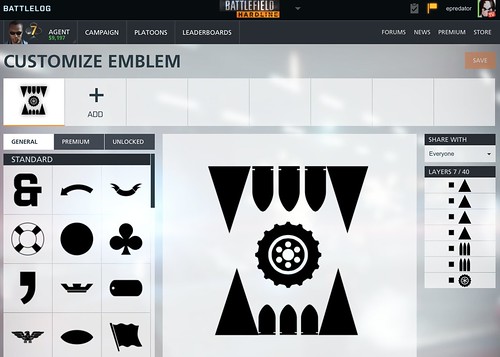
I may not be great at the game, as I bounce around looking for new experiences in games, but I do like a good bit of customisation to explore.
Unity 4.6 – A new UI
I have always really enjoyed developing in Unity3D as you may have noticed from my various posts and projects. Watching it evolve into such a major platform has been really interesting too. Yesterday Unity moved form version 4.5 to 4.6. Now in most systems a minor point release is not big deal. In fact the whole patch and push versioning with lack of backwards compatibility that bedevils the tech industry is something I find I have to battle with on a regular basis. Do a change in version numbers… no thanks. Except this is the exception to prove the rule.
Unity3d is great at allowing a developer to start placing objects in an environment, attaching behaviours and code to those objects. A lot can be done with point and click, drag and drop but there is also room for real lines of code and proper software engineering. In fact that is essential. I can however, with ease, make a 3d character animated and moving around, colliding with scenery etc. Up to now though if I wanted to use any other form of user input with a Graphical User Interface I had to really go back in time.
The GUI creation in 4.5 and since the earlier releases has been awful. In code in the OnGUI loop you had to try and describe layouts and positions where much of what you put was implied. So you have to describe the user interface and its behaviour with code that merges function with display whilst not being able to see where things are until you actually run it. This is the opposite of most of Unity3d which lets you see where things are in the development environment both when running and when not.
I have lost track of the number of times I have tried a “fancy” layout of buttons, one that starts nicely, with flowing positions based on screen resolution, only to get lost in the code and resort to fixed x,y positions which generally a hit and miss for the first few times. In Unity3d you can expose parameters to allow compound prefab objects to be configured without code changes. I have ended up with UI helper objects that change my spacing and positions at runtime, so I can tweak the numbers to try and shuffle buttons around. Unity3d is great at letting you move alter runtime values, and also great at going back to the originals when you stop running. Unfortunately this works against you on UI’s. You have to tweak the values then remember to write them down on a piece of paper before hit stop so that you can apply them in the code for next time once you get it ‘right’.
That may or may not make sense, but take my word for it, it was a right pain. Let alone what you then had to do to try and alter the look of the buttons, sliders etc with the GUI.Skin which is like CSS but much much worse. So all my research projects have had plain buttons. I am not a graphic designer, and I was not easily able to explain the UI process or how to work with designers to make is nicer.
All that is now gone though. The old way still works in 4.6 (which is a relief from a phased improvement position) but a new shiny UI creation tool and framework is now at last public. It has long been promised, by long I mean literally years! I am sure when I get to the depth of it there will be a few things that cause grief, but that programming folks!.
Now the UI exists as a real type of Unity3d visual object. If you create a layout area you can see it, a button its there all the time. Each of the objects is part of a proper event system but also many of the normal functions are exposed as parameters. If you want a button to do something when pushed you tell it in its setup which function to call.
Previous UI buttons were only ever placed on the view rectangle, like a Heads Up Display (HUD). I have often needed thing to be interactive element in a 3d environment but to act like buttons. Again I have worked around this but now a UI canvas and all its actions, roll overs etc can be detached as a hud and placed into the environment. In my hospital environment this means I can have an better AR style UI at each bed. I have that at the moment but it does not have all the nice feedback and customisation a UI element can have.
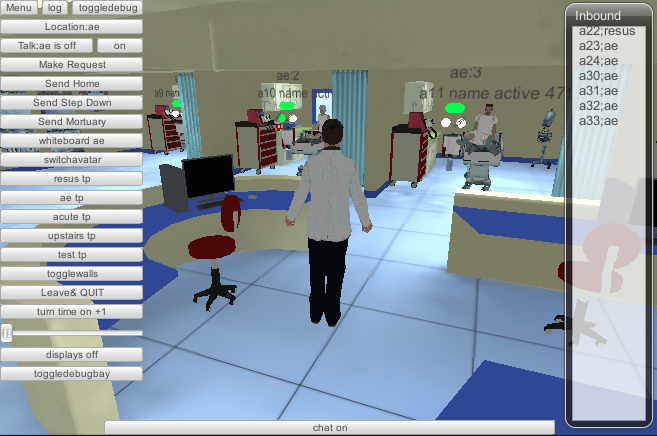
The other major change is how the UI elements can be typed and hence changed. Each element can be a regular button, slider etc but they can also be a graphic or even the result of another camera rendering a live texture.
Here is a the game view (though not running) of the demo UI. The continue button is highlighted so on the right are its properties, events etc. The mini menu is showing the choices just for that button on how to transition on normal events such as rollover and click. Here it is set to animation, hence it uses mechanim and potential can go flying around the screen twirling. Simpler transitions such as just a colour tint or a sprite swap can also be defined.
This was possible before but again it was a lot of messing around. The old system of what to do on a roll over etc was buried in the skin code or overridden in the onGUI. Now it makes use of the regular mechanim animation system. This state machine allows definition of all sort of things, and it how we make character jump and dive into rolls, duck etc. It makes sense to have that for more complex UI transitions and states. In multiplayer environments I use a mechanim state change value to send over the network to make sure any mirrored/ghosted network object acts in the same way. So I guess now I will be able to use that for UI’s too to keep players in synch with certain modal activity.
Anyway, this 4.6 and new UI is obviously a precursor to the much bigger Unity 5.0 coming very soon. However it has dropped at the right time for the next phase of a project, so I get to use it in anger and re-engineer something that just about works into something much better.
As I tweeted, this is a great xmas gift, than you Unity 🙂
